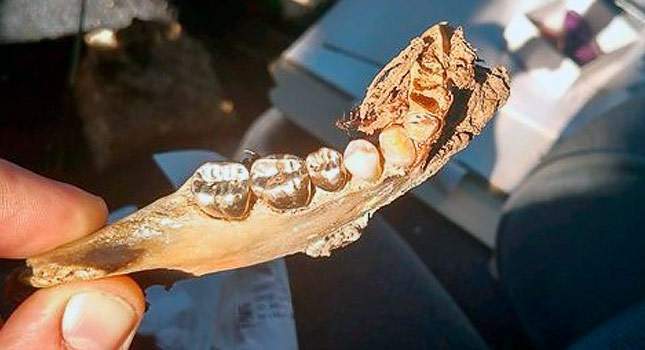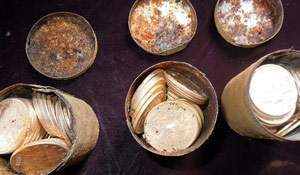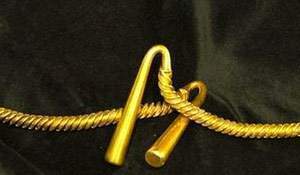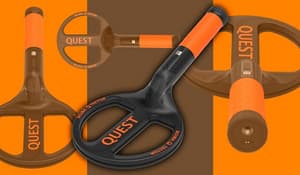There is a category ‘Gold finds’ in this blog. I made it exclusively to increase my own motivation – if once I see the posts from this category, with a great many gold items unearthed, I will immediately cheer myself up to go on a hunt… Supposing you found a jawbone with gold teeth, what would you do with it? Would you take it to a police station or keep it at home?
The object was found in Nevada, United States, by a novice treasure hunter who took it to a sheriff’s office and gave it to a sheriff. They appointed the forensic examination and DNA testing (to be carried out on the jaw). The find was made with a Teknetics Gamma 6000 machine.
I wonder what would you do if you picked up such a discovery. Would you take it to a police station or preserve it until your sunset years? Let us say, your teeth will fall out some day or other anyway, however, a young policeman won’t chew in your stead )) Or will he?
The video of how the teeth are being found with a metal detector is here. In the comments below there is another (unusual) option of picking up teeth. All gold finds are collected here. Those are really awesome!












Sehr informativer Beitrag! Vielen Dank f?rs teilen!
.
Pretty old post but I found loose gold teeth, no mandible. Smash the gold from the tooth like a specimen quartz rock is the easiest way to remove the tooth from the pliable gold. My Ex cashed them in since she didn’t think the find was as neat as I did and was smart enough not to let the gold buyer pay out at 14 karat since most gold teeth are 16 karat gold and that’s what she requested.. She always got first dibs on my finds, I lost almost all gold and silver that way. Had the Jaw been part of it I think one with no morals could remove the gold teeth and send the rest in for possible DNA testing. No DNA in gold and obviously a person wasn’t killed for their gold teeth since left in the mandible in in the picture. An argument could be made that the gold teeth could help identify a person with the dental records. I have never advertised or bragged about my finds so I wouldn’t care for any recognition if I found a mandible with gold teeth. Since they don’t give unclaimed body parts back if nobody claims them it’s a tuff one nowing regardless what happens to it, the found gold is forever lost to the finder. Perhaps a relative of the deceased would eventually end up with it. Luckily for me I didn’t have to make that decision. I would have probably let my ex make it knowing she would have turned it into the police but she still probably would have done it anonymously. That anonymous part could make it easier for one to extract the gold first.
Gold teeth are a normal find. How is it different from a gold ring?
You normally find them on the mandible (bottom jaw) ? Surprised then you didn’t notice the difference between a human body part and a gold ring. I understand you said teeth but notice the post. Or are you talking more on the lines of grave robbing with a digit attached still to the gold ring? Since that would be more on line with the OP’s topic of discussion.
So you would, or you do remove the gold teeth from the mandible and treat the teeth like a gold ring. Than what do you do with the jaws and skulls? Turn them in or leave them were you found it just missing the gold teeth? LOL
Will you pocket this find?
And if so?
This find was discovered with a XP Deus 2 metal detector.
Something like this
This is not my discovery. But you will like it.
The Battle of Waterloo in 1815, which marked the definitive defeat of Napoleon Bonaparte, left a profound impact not only on European politics but also on a strange, lesser-known chapter in dental history. On the battlefield, nearly 50,000 soldiers from both sides perished. However, amidst the tragedy, a macabre practice emerged: the extraction of healthy teeth from the dead to make dentures. These teeth, often called “Waterloo teeth,” were highly prized and became a significant part of dental prosthetics during the 19th century. The story of Waterloo teeth sheds light on the grim realities of medical practices at the time and offers a glimpse into the resourcefulness of a growing industry.
Before modern dentistry, the demand for dental replacements, particularly dentures, was high due to widespread tooth decay, poor hygiene, and lack of proper dental care. Wealthier individuals, who often suffered from severe dental problems, were willing to pay a premium for solutions that allowed them to eat and speak comfortably while maintaining a semblance of normal appearance. However, finding suitable materials for dentures posed a significant challenge. Human teeth, harvested from healthy individuals, were considered the best option, as they were more functional and less likely to be rejected by the body than alternatives like wood, ivory, or animal teeth.
The battlefield after Waterloo became a source of these precious teeth. Soldiers and scavengers alike collected the teeth of fallen soldiers, particularly focusing on young men who had healthy teeth due to their age and the relatively short duration of their service. Once extracted, these teeth were cleaned and shipped to England, where they were fashioned into dentures. It is important to note that the teeth from Waterloo were not the first to be harvested for this purpose, but they became iconic due to the scale of the battle and the subsequent availability of a large number of high-quality teeth.
These dentures, commonly referred to as “Waterloo teeth,” became synonymous with any dental prosthetics made from real human teeth, regardless of their origin. Over time, the term extended to cover all such prostheses, reflecting the popularity and widespread use of this grim resource. For many, wearing “Waterloo teeth” was a status symbol, as it indicated that the dentures had been made from human teeth rather than less effective materials. Ironically, these prosthetics, created from the remains of the fallen, often ended up in the mouths of wealthy civilians far removed from the horrors of war.
This practice, while disturbing by modern standards, was born out of necessity. Medical and dental science were still in their infancy, and the use of human teeth was seen as a practical solution to a widespread problem. The legacy of the “Waterloo teeth” reminds us of the often gruesome realities of the past and the lengths to which people were willing to go to address basic human needs such as eating and speaking. Today, advancements in dental materials and hygiene have rendered such practices obsolete, but the story of Waterloo teeth remains a fascinating chapter in the history of medicine and dentistry.